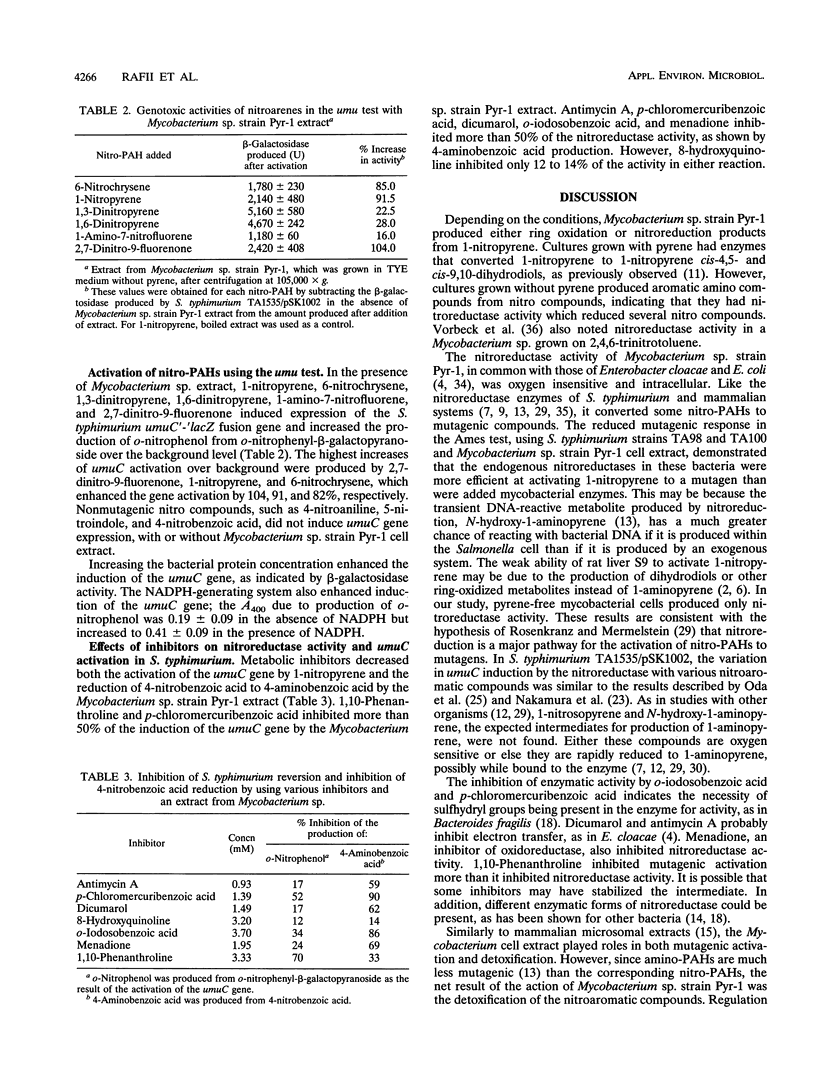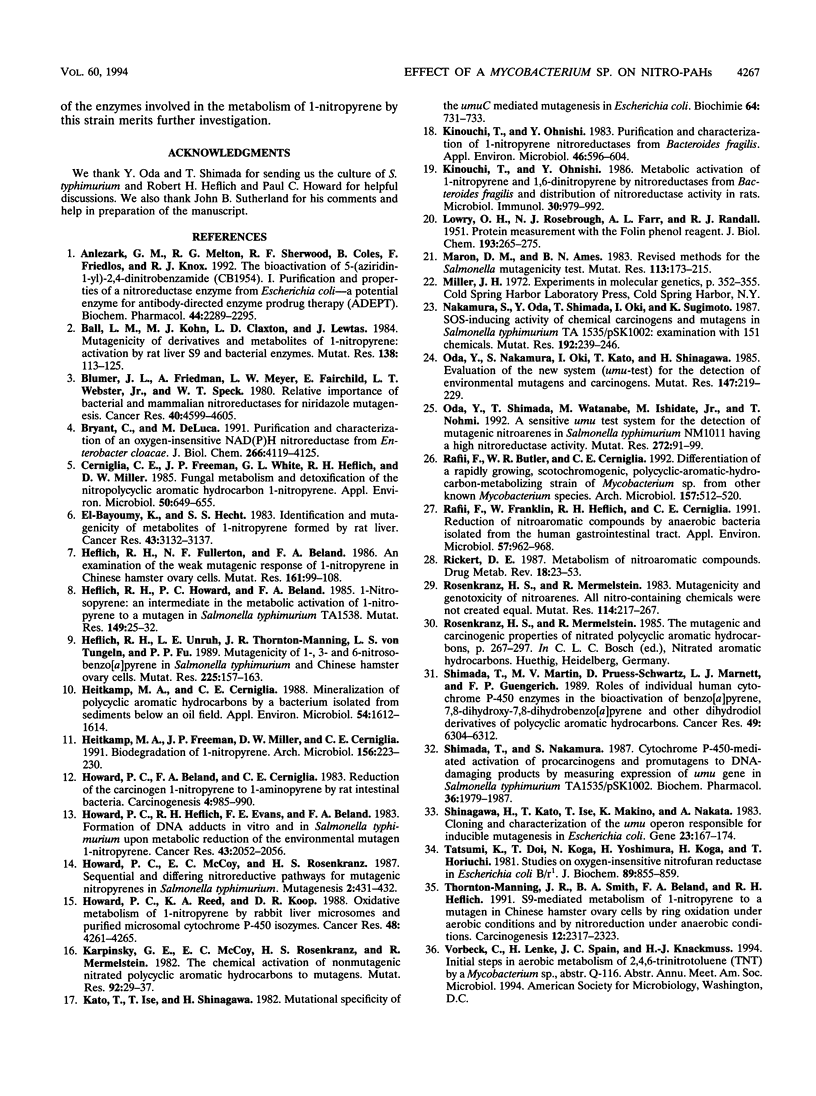Abstract
Mycobacterium sp. strain Pyr-1 cells, which were grown to the stationary phase in media with and without pyrene, were centrifuged and resuspended in a medium containing 1-nitropyrene. Cells that had been grown with pyrene oxidized up to 20% of the added 1-nitropyrene to 1-nitropyrene-cis-9,10- and 4,5-dihydrodiols. However, cells that had been grown without pyrene reduced up to 70% of the 1-nitropyrene to 1-aminopyrene but did not produce dihydrodiols. The nitroreductase activity was oxygen insensitive, intracellular, and inducible by nitro compounds. Nitroreductase activity was inhibited by p-chlorobenzoic acid, o-iodosobenzoic acid, menadione, dicumarol, and antimycin A. Extracts from cells that had been grown without pyrene activated 1-nitropyrene, 1-amino-7-nitrofluorene, 2,7-dinitro-9-fluorenone, 1,3-dinitropyrene, 1,6-dinitropyrene, and 6-nitrochrysene to DNA-damaging products, as shown in Salmonella typhimurium tester strains by the reversion assay and by induction of the umuC gene. Activation of nitro compounds, as shown by the umu test, was enhanced by NADPH. This study shows that Mycobacterium sp. strain Pyr-1 metabolizes nitroaromatic compounds by both oxidative and reductive pathways. During reduction, it generates products that are mutagenic.
Full text
PDF




Selected References
These references are in PubMed. This may not be the complete list of references from this article.
- Anlezark G. M., Melton R. G., Sherwood R. F., Coles B., Friedlos F., Knox R. J. The bioactivation of 5-(aziridin-1-yl)-2,4-dinitrobenzamide (CB1954)--I. Purification and properties of a nitroreductase enzyme from Escherichia coli--a potential enzyme for antibody-directed enzyme prodrug therapy (ADEPT). Biochem Pharmacol. 1992 Dec 15;44(12):2289–2295. doi: 10.1016/0006-2952(92)90671-5. [DOI] [PubMed] [Google Scholar]
- Ball L. M., Kohan M. J., Claxton L. D., Lewtas J. Mutagenicity of derivatives and metabolites of 1-nitropyrene: activation by rat liver S9 and bacterial enzymes. Mutat Res. 1984 Nov-Dec;138(2-3):113–125. doi: 10.1016/0165-1218(84)90033-8. [DOI] [PubMed] [Google Scholar]
- Blumer J. L., Friedman A., Meyer L. W., Fairchild E., Webster L. T., Jr, Speck W. T. Relative importance of bacterial and mammalian nitroreductases for niridazole mutagenesis. Cancer Res. 1980 Dec;40(12):4599–4605. [PubMed] [Google Scholar]
- Bryant C., DeLuca M. Purification and characterization of an oxygen-insensitive NAD(P)H nitroreductase from Enterobacter cloacae. J Biol Chem. 1991 Mar 5;266(7):4119–4125. [PubMed] [Google Scholar]
- Cerniglia C. E., Freeman J. P., White G. L., Heflich R. H., Miller D. W. Fungal metabolism and detoxification of the nitropolycyclic aromatic hydrocarbon 1-nitropyrene. Appl Environ Microbiol. 1985 Sep;50(3):649–655. doi: 10.1128/aem.50.3.649-655.1985. [DOI] [PMC free article] [PubMed] [Google Scholar]
- El-Bayoumy K., Hecht S. S. Identification and mutagenicity of metabolites of 1-nitropyrene formed by rat liver. Cancer Res. 1983 Jul;43(7):3132–3137. [PubMed] [Google Scholar]
- Heflich R. H., Fullerton N. F., Beland F. A. An examination of the weak mutagenic response of 1-nitropyrene in Chinese hamster ovary cells. Mutat Res. 1986 Jun;161(1):99–108. doi: 10.1016/0027-5107(86)90104-1. [DOI] [PubMed] [Google Scholar]
- Heflich R. H., Howard P. C., Beland F. A. 1-Nitrosopyrene: an intermediate in the metabolic activation of 1-nitropyrene to a mutagen in Salmonella typhimurium TA1538. Mutat Res. 1985 Mar;149(1):25–32. doi: 10.1016/0027-5107(85)90005-3. [DOI] [PubMed] [Google Scholar]
- Heflich R. H., Unruh L. E., Thornton-Manning J. R., von Tungeln L. S., Fu P. P. Mutagenicity of 1-, 3- and 6-nitrosobenzo[a]pyrene in Salmonella typhimurium and Chinese hamster ovary cells. Mutat Res. 1989 Apr;225(4):157–163. doi: 10.1016/0165-7992(89)90113-9. [DOI] [PubMed] [Google Scholar]
- Heitkamp M. A., Cerniglia C. E. Mineralization of polycyclic aromatic hydrocarbons by a bacterium isolated from sediment below an oil field. Appl Environ Microbiol. 1988 Jun;54(6):1612–1614. doi: 10.1128/aem.54.6.1612-1614.1988. [DOI] [PMC free article] [PubMed] [Google Scholar]
- Heitkamp M. A., Freeman J. P., Miller D. W., Cerniglia C. E. Biodegradation of 1-nitropyrene. Arch Microbiol. 1991;156(3):223–230. doi: 10.1007/BF00249119. [DOI] [PubMed] [Google Scholar]
- Howard P. C., Beland F. A., Cerniglia C. E. Reduction of the carcinogen 1-nitropyrene to 1-aminopyrene by rat intestinal bacteria. Carcinogenesis. 1983 Aug;4(8):985–990. doi: 10.1093/carcin/4.8.985. [DOI] [PubMed] [Google Scholar]
- Howard P. C., Heflich R. H., Evans F. E., Beland F. A. Formation of DNA adducts in vitro and in Salmonella typhimurium upon metabolic reduction of the environmental mutagen 1-nitropyrene. Cancer Res. 1983 May;43(5):2052–2058. [PubMed] [Google Scholar]
- Howard P. C., McCoy E. C., Rosenkranz H. S. Sequential and differing nitroreductive pathways for mutagenic nitropyrenes in Salmonella typhimurium. Mutagenesis. 1987 Nov;2(6):431–432. doi: 10.1093/mutage/2.6.431. [DOI] [PubMed] [Google Scholar]
- Howard P. C., Reed K. A., Koop D. R. Oxidative metabolism of 1-nitropyrene by rabbit liver microsomes and purified microsomal cytochrome P-450 isozymes. Cancer Res. 1988 Aug 1;48(15):4261–4265. [PubMed] [Google Scholar]
- Karpinsky G. E., McCoy E. C., Rosenkranz H. S., Mermelstein R. The chemical activation of non-mutagenic nitrated polycyclic aromatic hydrocarbons to mutagens. Mutat Res. 1982 Feb 22;92(1-2):29–37. doi: 10.1016/0027-5107(82)90207-x. [DOI] [PubMed] [Google Scholar]
- Kato T., Ise T., Shinagawa H. Mutational specificity of the umuC mediated mutagenesis in Eschericha coli. Biochimie. 1982 Aug-Sep;64(8-9):731–733. doi: 10.1016/s0300-9084(82)80119-3. [DOI] [PubMed] [Google Scholar]
- Kinouchi T., Ohnishi Y. Metabolic activation of 1-nitropyrene and 1,6-dinitropyrene by nitroreductases from Bacteroides fragilis and distribution of nitroreductase activity in rats. Microbiol Immunol. 1986;30(10):979–992. doi: 10.1111/j.1348-0421.1986.tb03028.x. [DOI] [PubMed] [Google Scholar]
- Kinouchi T., Ohnishi Y. Purification and characterization of 1-nitropyrene nitroreductases from Bacteroides fragilis. Appl Environ Microbiol. 1983 Sep;46(3):596–604. doi: 10.1128/aem.46.3.596-604.1983. [DOI] [PMC free article] [PubMed] [Google Scholar]
- LOWRY O. H., ROSEBROUGH N. J., FARR A. L., RANDALL R. J. Protein measurement with the Folin phenol reagent. J Biol Chem. 1951 Nov;193(1):265–275. [PubMed] [Google Scholar]
- Maron D. M., Ames B. N. Revised methods for the Salmonella mutagenicity test. Mutat Res. 1983 May;113(3-4):173–215. doi: 10.1016/0165-1161(83)90010-9. [DOI] [PubMed] [Google Scholar]
- Nakamura S. I., Oda Y., Shimada T., Oki I., Sugimoto K. SOS-inducing activity of chemical carcinogens and mutagens in Salmonella typhimurium TA1535/pSK1002: examination with 151 chemicals. Mutat Res. 1987 Dec;192(4):239–246. doi: 10.1016/0165-7992(87)90063-7. [DOI] [PubMed] [Google Scholar]
- Oda Y., Nakamura S., Oki I., Kato T., Shinagawa H. Evaluation of the new system (umu-test) for the detection of environmental mutagens and carcinogens. Mutat Res. 1985 Oct;147(5):219–229. doi: 10.1016/0165-1161(85)90062-7. [DOI] [PubMed] [Google Scholar]
- Oda Y., Shimada T., Watanabe M., Ishidate M., Jr, Nohmi T. A sensitive umu test system for the detection of mutagenic nitroarenes in Salmonella typhimurium NM1011 having a high nitroreductase activity. Mutat Res. 1992 Oct;272(2):91–99. doi: 10.1016/0165-1161(92)90037-m. [DOI] [PubMed] [Google Scholar]
- Rafil F., Franklin W., Heflich R. H., Cerniglia C. E. Reduction of nitroaromatic compounds by anaerobic bacteria isolated from the human gastrointestinal tract. Appl Environ Microbiol. 1991 Apr;57(4):962–968. doi: 10.1128/aem.57.4.962-968.1991. [DOI] [PMC free article] [PubMed] [Google Scholar]
- Rickert D. E. Metabolism of nitroaromatic compounds. Drug Metab Rev. 1987;18(1):23–53. doi: 10.3109/03602538708998299. [DOI] [PubMed] [Google Scholar]
- Rosenkranz H. S., Mermelstein R. Mutagenicity and genotoxicity of nitroarenes. All nitro-containing chemicals were not created equal. Mutat Res. 1983 Apr;114(3):217–267. doi: 10.1016/0165-1110(83)90034-9. [DOI] [PubMed] [Google Scholar]
- Shimada T., Martin M. V., Pruess-Schwartz D., Marnett L. J., Guengerich F. P. Roles of individual human cytochrome P-450 enzymes in the bioactivation of benzo(a)pyrene, 7,8-dihydroxy-7,8-dihydrobenzo(a)pyrene, and other dihydrodiol derivatives of polycyclic aromatic hydrocarbons. Cancer Res. 1989 Nov 15;49(22):6304–6312. [PubMed] [Google Scholar]
- Shimada T., Nakamura S. Cytochrome P-450-mediated activation of procarcinogens and promutagens to DNA-damaging products by measuring expression of umu gene in Salmonella typhimurium TA1535/pSK1002. Biochem Pharmacol. 1987 Jun 15;36(12):1979–1987. doi: 10.1016/0006-2952(87)90497-7. [DOI] [PubMed] [Google Scholar]
- Shinagawa H., Kato T., Ise T., Makino K., Nakata A. Cloning and characterization of the umu operon responsible for inducible mutagenesis in Escherichia coli. Gene. 1983 Aug;23(2):167–174. doi: 10.1016/0378-1119(83)90048-3. [DOI] [PubMed] [Google Scholar]
- Tatsumi K., Doi T., Koga N., Yoshimura H., Koga H., Horiuchi T. Studies on oxygen-insensitive nitrofuran reductase in Escherichia coli B/r. J Biochem. 1981 Mar;89(3):855–859. doi: 10.1093/oxfordjournals.jbchem.a133268. [DOI] [PubMed] [Google Scholar]
- Thornton-Manning J. R., Smith B. A., Beland F. A., Heflich R. H. S9-mediated metabolism of 1-nitropyrene to a mutagen in Chinese hamster ovary cells by ring-oxidation under aerobic conditions and by nitroreduction under anaerobic conditions. Carcinogenesis. 1991 Dec;12(12):2317–2323. doi: 10.1093/carcin/12.12.2317. [DOI] [PubMed] [Google Scholar]


